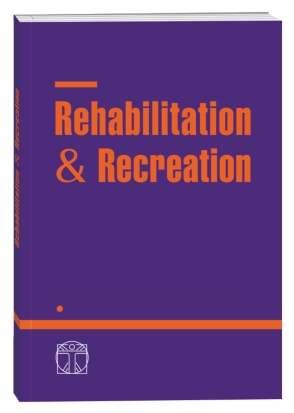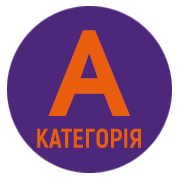THE IMPACT OF FUNCTIONAL DISORDERS ON THE STRUCTURE OF THE PROXIMAL PART OF THE THIGH AND THE HIP JOINT IN PATIENTS WITH A HISTORY OF STROKE
DOI:
https://doi.org/10.32782/2522-1795.2022.13.8Keywords:
stroke, hemiparesis, functioning, hip joint, limitation of life activities.Abstract
The aim. To establish the impact of functional impairment in patients with the stroke on the structure of the proximal part of the thigh and dysfunction of the hip joint. Material. The criteria for the inclusion of patients were cases of stroke with hemiplegia in the anamnesis. 87 patients participated in the study, who were divided into 4 groups: group 1 included 25 patients with signs of osteoarthritis (OA) of the hip, group 2 – 20 patients with signs of decreased mineral density of the proximal femur (PM), 3 – 12 patients with signs of OA and decreased mineral density of PM, 4 – 30 patients without signs of OA and decreased mineral density of PM. All patients underwent questionnaires, anthropometry, research of muscle strength of the lower limbs, range of motion in the hip, motor functions of the lower limbs, static and dynamic balance and risk of falling, level of spasticity, cardiorespiratory endurance, walking speed, level of cognitive functions were assessed. The results. Mineral density in PM in groups 2 and 3 was lower compared to representatives of group 4. Mineral density in group 1 was the highest and was 1244.2±51.6 HU (р<0.05). The lowest muscle strength was in group 3. Analysis of the range of motion in the hip showed that the greatest limitations were in groups 1 and 3. The lowest stage of motor recovery according to CMSA was recorded in the 3rd observation group. The value of motor functions according to CMSA in group 2 was greater than that of group 3, but lower than that of groups 1 and 4. The greatest disturbance of static balance was recorded in group 2, and the lowest level of dynamic balance was recorded in group 3. The value of the TUG test indicated the presence of reduced mobility and increased risk of falling in representatives of groups 2 and 3. In these groups, there was a decrease in walking speed and general endurance. Conclusions. It was found that in patients with the consequences of stroke and coxarthrosis, despite the decrease in the volume of movements in the hip, the density of PM, the speed and length of walking, and general mobility were increased. The most pronounced movement disorders were in the group of patients who combined signs of arthrosis and a decrease in bone mineral density, which was manifested by a violation of the muscle strength of the lower limb, limitation of movements in the hip, limitations of mobility, a decrease in walking speed and general endurance.
References
Абрамов В. В., Клапчук В. В., Неханевич О. Б., та ін. Фізична реабілітація, спортивна медицина. Дніпропетровськ, Журфонд. 2014. С. 455.
Голованова І. А., Бєлікова І. В., Ляхова Н. О. Основи медичної статистики. Полтава: ВДНЗУ «УМСА». 2017. С. 113.
Зубач О. Б., Григорєва Н. В. Показники 12-місячної летальності у хворих з переломом проксимального відділу стегнової кістки. Science Review. 2020. № 6 (33). С. 8–13. DOI: 10.31435/rsglobal_sr/30092020/7187.
Ігнатьєв О. М., Полівода О. М., Турчин М. І., Єрмоленко Т. О., Прутіян Т. Л. Клінічні рекомендації з діагностики, профілактики та лікування остеопорозу. Вісник морської медицини. 2019. № 3 (84). С. 28–38. DOI: 10.5281/zenodo.3465937.
Лоскутов О. Є., Курята О. В., Черкасова Г. В. Вплив ожиріння на структуру остеоартрозу великих суглобів нижньої кінцівки. Медичні перспективи. 2017. № 22 (2). С. 52–59. DOI: 10.26641/2307-0404.2017.2.10 9828.
Неханевич О. Б., Бакурідзе- Маніна В. Б., Смирнова О. Л., Бьон-Йоль Ю., Косинський О. В. Вплив мотивованої ходьби з частковим розвантаженням ваги тіла на великі моторні функції в дітей з церебральним паралічем. Медичні перспективи. 2020. № 25 (4). С. 107–114. DOI: 10.26641/2307-040 4.2020.4.221387.
Поворознюк В. В., Бистрицька М. А., Кошель Н. М. Остеопороз у пацієнтів, які перенесли мозковий інсульт. Травма. 2018. № 19 (6). С. 48–53. DOI: 10.22141/1608-1706. 6.19.2018.152220.
Ahmad Ainuddin H., Romli M. H., Hamid T. A., Sf Salim M., Mackenzie L. An Exploratory Qualitative Study With Older Malaysian Stroke Survivors, Caregivers, and Healthcare Practitioners About Falls and Rehabilitation for Falls After Stroke. Front Public Health. 2021. No. 9, рр. 611814. DOI: 10.3389/fpubh.2021.611814.
DenOtter T. D., Schubert J. Hounsfield Unit. 2022 Mar 9. In: StatPearls [Internet]. Treasure Island (FL): StatPearls Publishing; 2022 Jan. PMID: 31613501.
Huang Y. D., Li W., Chou Y. L., Hung E. S., Kang J. H. Pendulum test in chronic hemiplegic stroke population: additional ambulatory information beyond spasticity. Sci Rep. 2021. No. 11 (1), рр. 14769. DOI: 10.1038/ s41598-021-94108-5.
Jenkin J., Parkinson S., Jacques A., Kho L., Hill K. Berg Balance Scale Score as a Predictor of Independent Walking at Discharge among Adult Stroke Survivors. Physiother Can. 2021. No. 73 (3), рр. 252–256. DOI: 10.3138/ ptc-2019-0090.
Köseoğlu B. F., Akselim S., Kesikburun B., Ortabozkoyun Ö. The impact of lower extremity pain conditions on clinical variables and healthrelated quality of life in patients with stroke. Top Stroke Rehabil. 2017. No. 24 (1), рр. 50–60. DOI: 10.1080/10749357.2016.1188484.
Luo L., Meng H., Wang Z., Zhu S., Yuan S., Wang Y., Wang Q. Effect of highintensity exercise on cardiorespiratory fitness in stroke survivors: A systematic review and meta-analysis. Ann Phys Rehabil Med. 2020. No. 63 (1), рр. 59–68. DOI: 10.1016/j. rehab.2019.07.006.
Manikowska F., Chen B. P., Jóźwiak M., Lebiedowska M. K. Validation of Manual Muscle Testing (MMT) in children and adolescents with cerebral palsy. NeuroRehabilitation. 2018. No. 42 (1), рр. 1–7. DOI: 10.3233/NRE-172179.
Martino Cinnera A., Bonnì S., Pellicciari M. C., Giorgi F., Caltagirone C., Koch G. Health-related quality of life (HRQoL) after stroke: Positive relationship between lower extremity and balance recovery. Top Stroke Rehabil. 2020. No. 27 (7), рр. 534–540. DOI: 10.1080/10749357.2020.1726070.
Marzolini S., McIlroy W., Tang A., Corbett D., Craven B. C., Oh P. I., Brooks D. Predictors of low bone mineral density of the stroke-affected hip among ambulatory individuals with chronic stroke. Osteoporos Int. 2014. No. 25 (11), рр. 2631–8. DOI: 10.1007/ s00198-014-2793-3.
Narayanan A., Cai A., Xi Y., Maalouf N. M., Rubin C., Chhabra A. CT bone density analysis of low-impact proximal femur fractures using Hounsfield units. Clin Imaging. 2019. No. 57, рр. 15–20. DOI: 10.1016/j. clinimag.2019.04.009.
Osterhoff G., Scheyerer M. J., Ullrich B., Osterhoff G., Spiegl U. A., Schnake K. J. Arbeitsgruppe Osteoporotische Frakturen der Sektion Wirbelsäule der Deutschen Gesellschaft für Orthopädie und Unfallchirurgie. Der Unfallchirurg. 2019. No. 122 (8), рр. 654–661. DOI: 10.1007/s00113-018-0511-x.
Panwar N., Purohit D., Deo Sinha V., Joshi M. Evaluation of extent and pattern of neurocognitive functions in mild and moderate traumatic brain injury patients by using Montreal Cognitive Assessment (MoCA) score as a screening tool: An observational study from India. Asian journal of psychiatry. 2019. No. 41, рр. 60–65. DOI: 10.1016/j.ajp.2018.08.007.
Pollock C. L., Hunt M. A., Garland S. J., Ivanova T. D., Wakeling J. M. Relationships Between Stepping-Reaction Movement Patterns and Clinical Measures of Balance, Motor Impairment, and Step Characteristics After Stroke. Phys Ther. 2021. No. 4 (101(5), рр. pzab069. DOI: 10.1093/ptj/pzab069.
Povoroznyuk V. V., Dedukh N. V., Bystrytska M. A., Dzerovych N. I., Shapovalov V. S. The association of sarcopenia and osteoporosis and their role in falls and fractures (literature review). Medicni perspektivi. 2021. No. 26 (2), рр. 111–119. DOI: 10.26641/2307-0404.2021.2 .234637. 22. Sözen T., Özışık L., Başaran N. Ç. An overview and management of osteoporosis. Eur J Rheumatol. 2017. No. 4 (1), рр. 46–56. DOI: 10.5152/eurjrheum.2016.048.
Thong I., Jensen M. P., Miró J., Tan G. The validity of pain intensity measures: what do the NRS, VAS, VRS, and FPS-R measure? Scandinavian journal of pain. 2018. No. 18 (1), pp. 99–107. DOI: 10.1515/sjpain-2018-0012.
Wang H. P., Sung S. F., Yang H. Y., Huang W. T., Hsieh C. Y. Associations between stroke type, stroke severity, and pre-stroke osteoporosis with the risk of post-stroke fracture: A nationwide population-based study. Journal of the Neurological Sciences. 2021. No. 427, рр. 117512. DOI: 10.1016/j.jns.2021.117512.
World Health Organization (WHO). Health statistics and information systems. Available from: https://platform.who.int/ mortality/themes/theme-details/topics/ indicator-groups/indicator-group-details/MDB/ cerebrovascular-disease.
Worthen L. C., Kim C. M., Kautz S. A., Lew H. L., Kiratli B. J., Beaupre G. S. Key characteristics of walking correlate with bone density in individuals with chronic stroke. J Rehabil Res Dev. 2005. No. 42, рр. 761–68. DOI: 10.1682/jrrd.2005.02.0036.
Yang F. Z., Jehu D. A. M., Ouyang H., Lam F. M. H., Pang M. Y. C. The impact of stroke on bone properties and muscle-bone relationship: a systematic review and meta-analysis. Osteoporos Int. 2020. No. 31 (2), рр. 211–224. DOI: 10.1007/s00198-019-05175-4.
Yu L., Zhu Y., Chen W., Bu H., Zhang Y. J. Incidence and risk factors associated with postoperative stroke in the elderly patients undergoing hip fracture surgery. Orthop Surg Res. 2020. No. 15 (1), рр. 429. DOI: 10.1186/ s13018-020-01962-6.
Zhang L., Zhang T., Sun Y. A newly designed intensive caregiver education program reduces cognitive impairment, anxiety, and depression in patients with acute ischemic stroke. Braz J Med Biol Res. 2019. No. 52 (9), рр. e8533. DOI: 10.1590/1414-431X20198533.
Downloads
Published
How to Cite
Issue
Section
License

This work is licensed under a Creative Commons Attribution-NonCommercial-NoDerivatives 4.0 International License.












